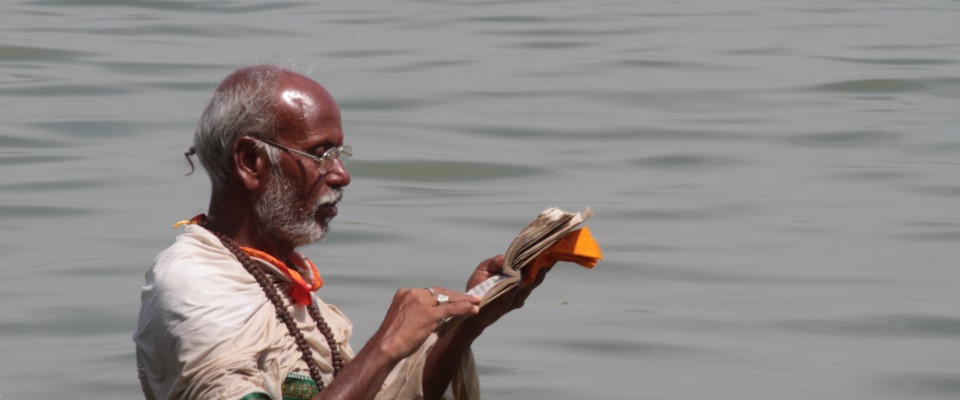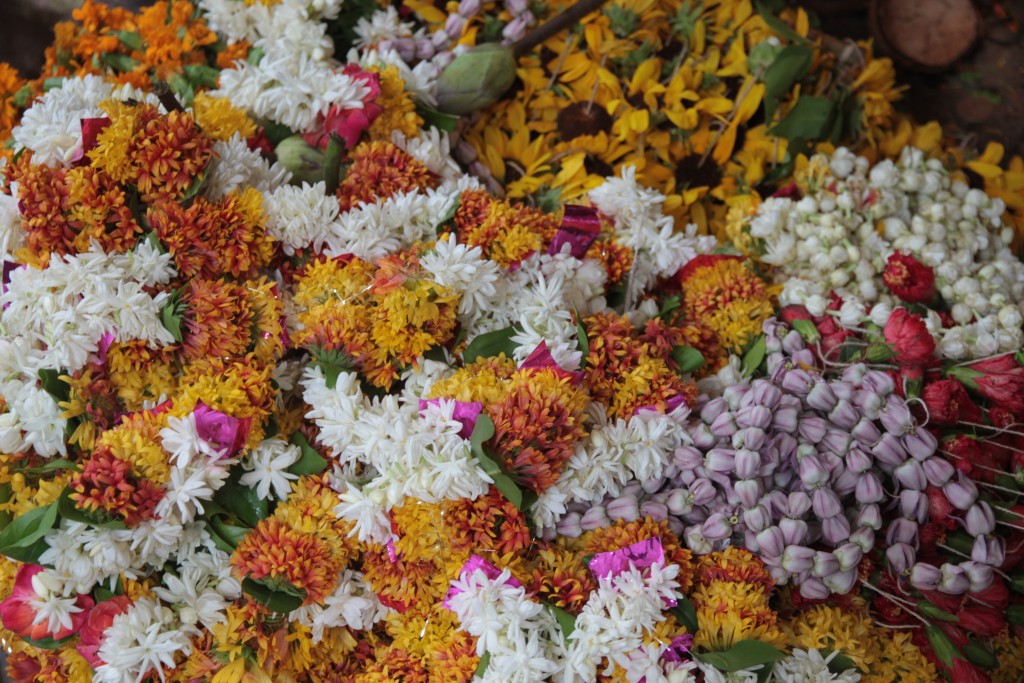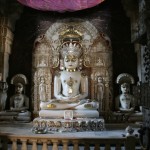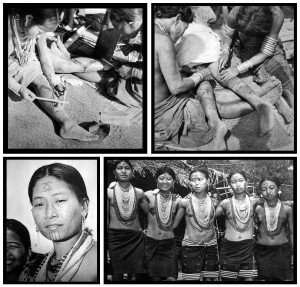India is the crib of the four main religious traditions. Here are the results of the last census :
- Hindouism 82,41%
- Bouddhism 0,77%
- XXX 0,77%
- Sikhism 1,99%, but mostly in Penjab
We can add to that four other great traditions which have a long history in India :
- The XXX or the XXX, 80% of them live in Maharastra, others live in Gujarat.
- Judaism
- Catholicism 2,32%
- Islamism 11,67%, mostly in Cashemire
To be thorough, we should add :
- Bahaism
Religious minorities
- Kukis
- Nagas
- Bodos
- Chakmas
- Hajongs
Religion in India is of great importance In our indian friend’s daily life, it plays an essential part. It gives social and cultural life their rythme. Each religion in India influenced architecture, sculpture, painting, music, and even medecine. Almost all the great religions of the world are represented in India. One can notice, however, that religious values among the city-dweller youth are shrinking. India is very proud of its religious diversity. Nevertheless, interfaith weddings remain rare and tensions within different communities, mostly between hindus and muslims, keep on disturbing certain states.
Hindouism
It is the main religion. Around 84% of the population of India is Sanatana Dharma. It is one of the oldest religion in the world. The Sanatana Dharma is rather more a way of life and of thinking, than an organised religion.
Supreme court of India defined the shapes of « Hindu faith » in 1966, as it follows :
- respectful acceptance of Veda as the Highess Authority on religious and philosophical subjects as well as respectful acceptance of Veda by hindu thinkers and philosophers as unique base for hindu philosophy.
- spirit of tolerance and good will to understand and appreciate the other’s point of view, based on the unveiling that truth holds many appearances
- acceptation among all of the six philosophical hindu systems of a world rythm, that experiences times of creation, upkeeping and destruction, times – or Yuga – that goes on endlessly
- acceptance of the faith of reincarnation and the pre-existence of beings from all the philosophical hindu systems
- identification to the fact that means to get to salvation are diverse
- the understanding of truth, that, as many divinities as there is to worship, one can be a hindu and not belive that idols must be worhiped
- unlike other religions or beliefs hindu religion is not linked to a defined ensemble of philosophical concepts.
A hindu is therefore someone who belives the philosophy presented in the Veda (The Knowledge). Veda are the oldest religious writings in the world. The principle of this teaching is that the true nature of man is divine : God, or the Brahman, lives in each living thing.
This tradition is therefore an exploration of inside knowledge, a search of the divine that lies in each individual.
For the Veda, no one needs to « be saved », since no one is ever lost. One only lives in ignorance of one’s profund and divine nature.
This religion is based on sacred fundamental texts that explain the samsara, the karma, the dharma and the castes. Hindus believe that human life is cyclic : after death, the soul reincarnates (the samsara) in a new body, either human, animal, or plant, depending on its acts. They believe that the karma of the ongoing life can lead to reincarnation in an inferior caste, or even in an animal. To reach « moksha », which is the freeing of the cycle of rebirths (samsara), one has to free himself from the power of suffering, from attachment, and from ignorance.
Nowadays, hinduism belief is based either on faith, or on philosophy, or sometimes a mix of both. It is known that there are many different approaches of the Divine, all of which are valid. No matter the spiritual practice, as long as it leads to the same state of self-acheivement. The Veda teach the respect of all beliefs and in doing so, differenciate themselves from most of the other religions.
Sacred hinduism books are : the four Veda that constitute the fundamentals of the philosophy, the Upaniṣad, the Mahābaratha, the Rāmāyaṇa, the Bhagavad Gītā.
The Hindu trinity : Brahmā, Shiva, Viṣṇu.
Brahmā, the God creator, symbolizes the Supreme Truth. His spouse Sarasvati is the Goddess of knowledge, of music, and arts.
Shiva, the God who breaks the evil and the ignorance, as well as the God who regenerates. He is often pictured as a naked ascetic with a snake around his waist, a trident, and riding a white bull called Nandi. His spouse (his consort) is Parvati, they have two children : Ganesh, the God with an elephant’s head, and Karttikeya (Skanda or Murugan south of India). Ganesh is the most invocated God, for he is known for removing obstacles et bringing wisdom.
Viṣṇu, the conservative God, is said to be eternal, associated to primitive waters, and considered as omnipresent before the creation of the Universe. His spouse, Lakshmi, is the Goddess of beauty and wealth. It is only several years later, that the conception of Vishnu as the rescuer of the world appeared, incarnating as differents avatara(s), when the equilibrium of the world is in danger.
Bouddhism
Buddhism is the third biggest religion in the world after christianism and islamism. Only 7 millions of people are considered buddhists nowadays in India, including our fellow refugees friends from Tibet.
Buddhism was created in year 500 before J.C., when prince Siddhârta Gautama (546-324, the future Buddha) left in the search for illumination and ended up reaching nirvana.
Buddhism in India reached golden age during the Maurya empire, under the reign of Ashoka (Açoka) who converted himself to buddhism. By the end of this empire, buddhism shrinked and was evicted by hinduism.
According to the buddha, life rests on four noble truths : Duhka, Samudaya, Nirodha, Marga.
- The first noble truth, called Duhka in sanskrit, if often translated by « suffering » or « pain », which means « asking life what it cannot give us ».
- The second noble truth, called Samudaya, means that pains exist because of some reasons. Therefore it is normal to know those reasons.
- The third noble truth, called Nirodha, means the end, the termination, or the end of the pains.
- The fourth noble truth, called Marga, is the voice that leads to the termination of suffering.
Suffering is caused by desirs. To avoid any, one must follow the path that leads to comprehension. Anyone following that path gets rid of desirs and hate, and reaches inner peace as well as « Nirvana ». All of that leads to the end of the reincarnation cycles of the soul.
Buddhism is not a religion, it is a philosophy. There are two schools considered as leaders in buddhism : Hinayana, for exemple in Sri Lanka, where it is more strict, and Theravada, the one of our fellow Tibetan friends.
One must notice that in hinduism, Buddha is considered as the ninth incarnation of the Vishnu God.
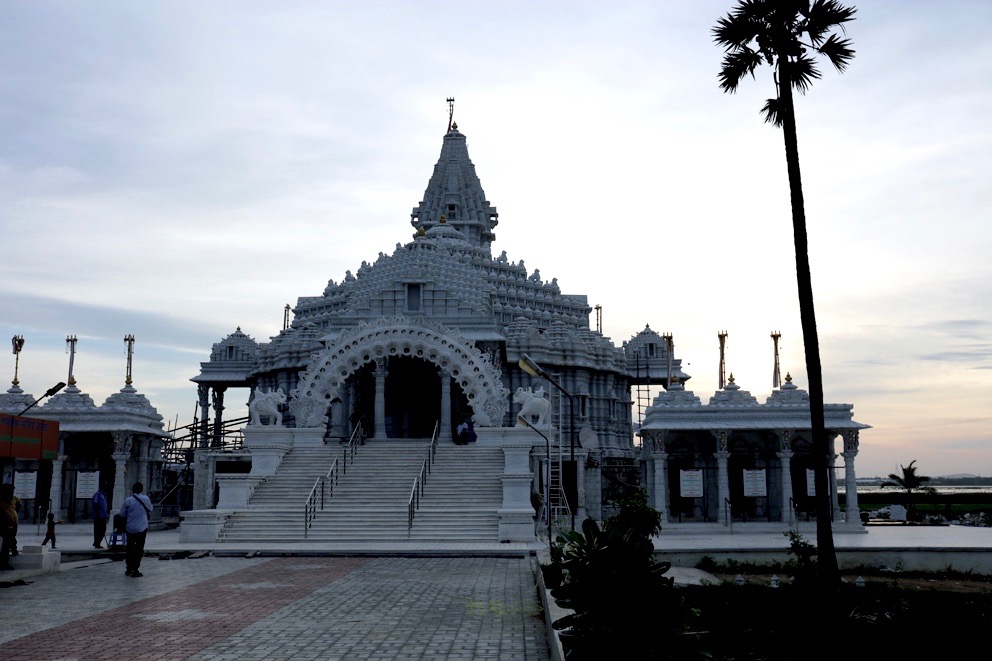
Jaïn Temple near Mahabalipuram, Tamil Nadu
Janism
About 4 millions people are concerned in India. Janism was founded by Mahariva during the sith century before J.C. Mahariva is contemporary to Buddha, who himself also preached atheism, or the absence of a God. Mahariva is the last of the 24 « Tirthankara(s) » or « boatman ». Jainism is therefore a religion without a God.
The jains believe that only a truly pure soul can reach liberation.
To purify it, one has to let go of his Karma through fasting, meditation, and Yoga. The Jains try hard not to harm any sort of life. One can come accross an ascetic Jain with a tissue convering his mouth so that he does not swallow any insect or microscopic being, as well as sweeping before his feet to not step on any.
They belive that one can obtain the termination of rebirths by destroying the accumulated Karma of his previous lives.
Jains, who are ascetic and not harmful, have influenced Hinduism and Yoga a great deal. Hinduism and Yoga actually get the principle of ahimsa (non-violence) from the Jains.
Mahârîva established five ways of getting rid of perpetual rebirths :
- Do not destroy life
- To tell the truth
- To be single
- To possess nothing
- To not accept anything that is not given freely
The Jain community is strictly vegetarian, it does not wear leather or perfume, and a women does not enter a temple on her period.
Islamism
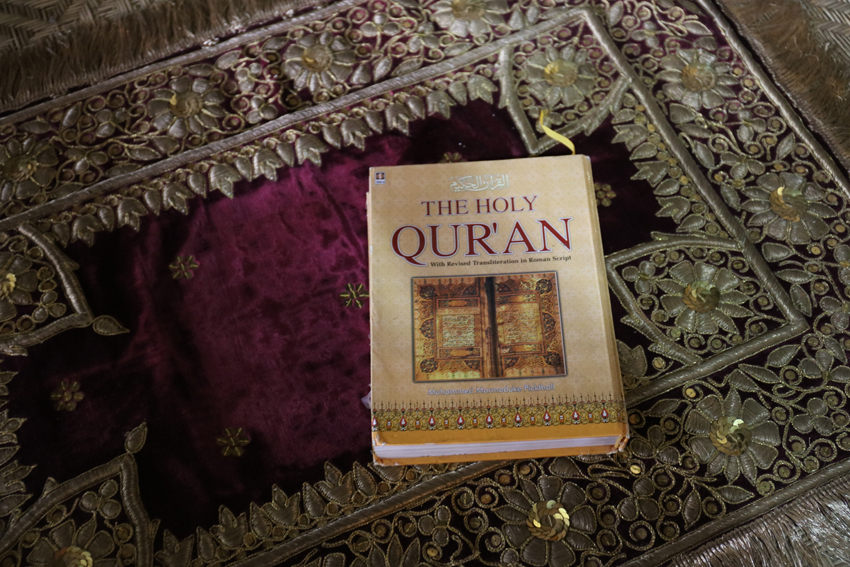
During the eith century, arab traders brought their faith along to India. Muslims are the largest minority in India. Almost 12% of the population is « Sunni ». The prophet Muhammad founded islam. He was born in Mecca in Saudi Arabia in 570 after J.C. Islam is a very strict monotheist religion : « Allah is God and Muhammad is his prophet ». The Coran is the sacred book for muslims. It advocates universal brotherhood and submission to Allah. Five « pillars » support the religious life of those who belive :
- Declaration of faith
- Praying five times a day
- Ramadan fasting
- Pilgrimage to Mecca once
Christianism
It is traditionally said thay christianism arrived with India along with Saint Thomas the apostle, one of the Christ’s apostles. He might have evangelized the Kerala and the Tamil Nadu. He may have died as a martyr in Madras and burried in St Thomas Cathedral. A second wave of christianism might have come along with the Syriac church. It reached India through Syrian traders who came to Kerala with their families to settle there. The third wave came during the fifteenth century, when the Portugueses arrived. The miraculously intact corps of Saint François Xavier can still be seen at Don Jesus Basilica in Goa.
There are about 19 millions of christians in India, most of whom live in the south (Tamil Nadu and Kerala)
Christianism and its teachings influenced numerous ascetics such as Ramakrishna, intellectuals, or Mahatma Gandhi.
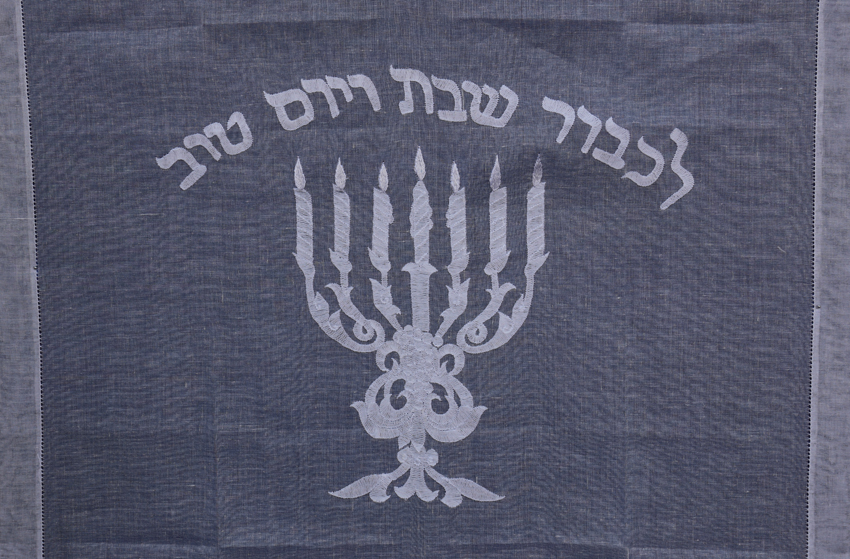
Blessings and praises in honor of the Sabbath
Judaism
The jewish people arrived in Kochi during the wixth century before J.C. The jewish tradition align itself to Abraham, father of the believers and of Moses. He is Israel’s legislator.
The holy book is the Torah.
There are three disctinct communities, all of which are sephardic : one in Goa, the Bnei Israel in Maharashtra state, and the baghdadi, who arrived from Irak, Iran and Syria two centuries ago because of persecutions in their own countries. They follow the sephardic ritual but without a rabbi. Most of them are settled in Mumbai and Kolkotta.
The jewish community represents around 5000 members. This can be explained by the emigration of several jews to Israel, the United Kingdom, the United States, Canada and Australia.
The parsee
It is a monotheist religion. The believers are called parsee. Their God, Ahura Mazda, is invisible and omnipotent. Zoroastrism was founded by Zoroastre, who was a priest and lived in eastern Persia. They are the descendants of immigrants from Persia in the tenth century who ran from muslim persecutions.
Their holy book is the Zend-Avesta. It describes the conflict between good and evil and it was written by the prophet Zarathoustra.
Zoroastrism is based on each man and woman’s responsability to choose between good or evil. This religion rejects practices such as fasting and celibacy.
According to them, man, who is mortal, holds eternal elements such as the soul. Those who acted well on earth, through their acts and speech are supposed to have a pleasurable existence in the after life. To the contrary,
Nowadays, most of India’s Zoroastrians live in Mumbai and are called Parsis.
It is the most urban religious group as well as the wealthiest of the indian nation (industries, finances, high technologies etc.).
Parsis do not burry their dead ones, nor do they incinerate them. In Mumbai, there are the renowned « Towers of silence » that are open to the sky. The elements being sacred for Parsis, those can not burry their dead ones or they believe it would ruin the ground. They can neither incinerate, for it would ruin the fire. Therefore, they lay their dead ones on top of high towers so that crows and vultures and scavengers take care of the remains in less than an hour.
Website : http://w-z-o.org
Bahaism
Mostly present in the United-Stats, in Europe, in India and the Middle-East, the baha’is were harshly persecuted in Iran. Bahaism is a religious syncretism in which ritual assemblies include readings of the Bible, the Gospels and the Coran.
Baha’ie’s faith claims itself to be a « wordly independant religion ». It was founded by the Persian Mirza Husayn-‘Ali Nuri, who was the Bab disciple (Sayyid ‘Ali Muhammad Sirazi)
Baha’is consider all of the Bab and Baha’u’llah’s writings as divinely revealed under the influence of the Holy Spirit.
« True religion and science are not contradictory. When a religion is opposed to science, it becomes mere superstition. What is contrary to knowledge is ignorance. How can a man believe in the reality of a fact that was demonstrated as false by science ? If, against all senses, he still believes it, it is rather because of a blinded superstition than because of faith. The true principles of all the religions are conform to the teachings of science. (…) religion and science are the two wings that allow men’s intelligence to raise towards hights, and allow the human soul to progress. It is not possible to fly with only one wing. Someone trying to fly with the wing of religion only would soon fall into the swamp of superstition. Whereas, with the only wing of science, he would do no progress and sink into the hopeless rut of materialism. »
Conversations of ‘Abdu’l-Baha in Paris,
paragraphs 55.2-4 (page 124) and 55.15-16 (page 126)
Tribal religious minorities
On that subject, read the book « AU PAYS DES FEMMES GIRAFES » by Vitold de Golish, expeditions 1955 and 1957 in Burma, assisted by Pierre de Arceluz.
Text and photographs by Vitold de Golish, Arthaud Editions (1958).
- Kukis
- Nagas
- Bodos
- Chakmas
- Hajongs
Half of those primitive tribes that make up this region of India are either buddhists or animists. Others were partially converted to christianism recently.
Kukis
They are part of wild mongoloid tribes known in India. They are essentially spread in the North-East of India, Burma, and in Bangladesh. Traditionally animist, they were converted by different missionaries (Christians, Protestants, Baptists etc.)
Nagas
They are also spread in the Nort-East region of India. They are about two and a half millions. Nagas are divided in 30 tribes, between the states of Nagaland, Manipur, Assam, Arunachal Pradesh, Burma.
Social and religious structures could vary. Each clan lived in self-sufficiency and ha dits own cultural landmarks. Their cultures almost remained unaltered before the arrival of missionaries (essentially Baptists in the 20th century).
We do not know much about their life, except that they were hunter-gatherers, and that tribal wars were frequent. Nagas were head-beheaders until the 1960’s. This custom was banned in 1991.
Nowadays, 80% of Nagas are evangelised.
With the influence of missonaries, the practice of traditional tattoo weakened. Although it is declining, it still plays an important part in their customs. Young women of age to be married usually get their legs and forehead tattooed. The dyes come from a plant. Tattooers inject it under the skin with a needle attached to a stick. The geometrical drawings on the legs prevent the body from Hla’s bites. He is the legendary vampire who fed from women and snake’s blood.
Nagas villages were surrounded by defensive fences. Two particular buildings were found. The morung, which is the men’s and the women’s dormitory. Men from the village could not get into the women’s dormitory. Only men from another village could.
Official website of Nagaland : http://nagaland.nic.in
Bodos, or Boros
Bodos are the first authentified inhabitants of the Assam. They are part of the Indian Constitution. They speak Bodo, which has a burman and tibetan origin. According to the last census of 1991, they are 1,2 millions, which represents 5,3% of India.
At India’s independance in 1947, Bodos represented 49% of the population of the Assam. But successive migrations and colonizations from muslims of Bengalis origin, as well as other communities, relegated them to a minority.
The consequence of those migrations were the spoliation of their lands and a loss of their economical strengh, as well as their identity.
The traditional and favorite beverage of Bodos is rice beer (Zu Mai), which means :
Zu : beer, and Mai : rice.
Many families grow their own rice silkworms. Weaving is another important part of their culture. Girls are taught very early to weave. Most of women weave their own « Dokhnas » clothes and wraps. The Bodos are also wonderful craftsmen with products made of bamboo.
Their religion
In terms of religion, the practice is a mix between primary animist faith, hinduism and christianism.
Bathouism (the faith of Bodos) is not strictly animist, although strangers believed so. It is based on the belief that God is infinite and is forever called Obonglaoree. The legend says that the infinite God got tired of its shapeless existence and therefore took the shape of a human being called Jiw Borai, or old soul. It is a way of honouring its ancestors. The number « Five » is a symbolic and important one in the Bodo religion.
Efforts were made to identify the « Jiw Borai » God with the hindu God « Siva ». Several elements of hinduism were incorporated in the Bodos religion throughout times.
There are no rooted cultural place for Bodo. The altar is placed in whichever place that is convinient around the house, usually in the courtyard. For the most important Bodo festival, the Kherai Puja, the altar is placed in the paddy field for spring and fertility rituals.
Despite the progress of hinduism in Bodo culture, hindu practices such as castes and dowry are not practiced. They are non-vegetarians.
Readings on that subject :
Le Bodos : Enfants du Bhullumbutter, published by Thomas Pulloppillil and Jacob Aluckal, first published in 1997.
Website : http://udalguri.gov.in/bodo.htm
Chakmas
They live under the authority of a king. Their social system is original. They preserved the ancient sorting in gutthi(s) (first clans of Chakma), from the historical groupings around the village chief. With the growing of their people, the gutthi(s) gave birth to the Goja(s).
They call themselves Changma.
The chakma language, the Changma Kodha, belongs to a group called « bengali-assamais ». It is associated to the Indo-european language. Chakma has its own writing. But this one is on the verge of disappearance, because many Chakma(s) do not have the opportunity to learn their language at school.
The Chakma(s) people originated from the North-East of India (Arunachal Pradesh), and from Bangladesh, a region of hills overhanging the delta of Gange, which is shelter to a dozen of ethnies very different from the bengali majority, in terms of way of life, language, religion, culture and even physical traits.
Since over fifty years in Bangladesh, those peoples undergo agressions from those who want to chase them off their land (persecutions, massacres). Many of them had to leave Bangladesh to take refuge in India and in the rest of the world.
The Chakma(s) are buddhists.
« Ajha » (in chakma language means) « hope ».
The Hajongs
From a tibetan and burman origin, the Hajongs is a population that lives the meridional Piedmont of Megalaya (its name means the « Dwelling of the clouds » in sanskrit). Tribal population from an aboriginal origin were called « The men from the mountains » (Hill tribes) ». At the 1951 census, around thirty thousand of them were established in that time’s eastern Pakistan. Because of the missionaries, most of them are hindus and christians.
Official website of Megalaya : http://meghalaya.gov.in:8080/megportal/
